+ データを開く
データを開く
- 基本情報
基本情報
| 登録情報 | データベース: PDB / ID: 1at9 | |||||||||
|---|---|---|---|---|---|---|---|---|---|---|
| タイトル | STRUCTURE OF BACTERIORHODOPSIN AT 3.0 ANGSTROM DETERMINED BY ELECTRON CRYSTALLOGRAPHY | |||||||||
 要素 要素 | BACTERIORHODOPSIN | |||||||||
 キーワード キーワード | PHOTORECEPTOR / PROTON PUMP / MEMBRANE PROTEIN / RETINAL PROTEIN / TWO-DIMENSIONAL CRYSTAL | |||||||||
| 機能・相同性 |  機能・相同性情報 機能・相同性情報light-driven active monoatomic ion transmembrane transporter activity / monoatomic ion channel activity / photoreceptor activity / phototransduction / proton transmembrane transport / plasma membrane 類似検索 - 分子機能 | |||||||||
| 生物種 |  Halobacterium salinarum (好塩性) Halobacterium salinarum (好塩性) | |||||||||
| 手法 | 電子線結晶学 / クライオ電子顕微鏡法 / 解像度: 2.8 Å | |||||||||
 データ登録者 データ登録者 | Kimura, Y. / Vassylyev, D.G. / Miyazawa, A. / Kidera, A. / Matsushima, M. / Mitsuoka, K. / Murata, K. / Hirai, T. / Fujiyoshi, Y. | |||||||||
 引用 引用 |  ジャーナル: Nature / 年: 1997 ジャーナル: Nature / 年: 1997タイトル: Surface of bacteriorhodopsin revealed by high-resolution electron crystallography. 著者: Y Kimura / D G Vassylyev / A Miyazawa / A Kidera / M Matsushima / K Mitsuoka / K Murata / T Hirai / Y Fujiyoshi /  要旨: Bacteriorhodopsin is a transmembrane protein that uses light energy, absorbed by its chromophore retinal, to pump protons from the cytoplasm of bacteria such as Halobacterium salinarium into the ...Bacteriorhodopsin is a transmembrane protein that uses light energy, absorbed by its chromophore retinal, to pump protons from the cytoplasm of bacteria such as Halobacterium salinarium into the extracellular space. It is made up of seven alpha-helices, and in the bacterium forms natural, two-dimensional crystals called purple membranes. We have analysed these crystals by electron cryo-microscopy to obtain images of bacteriorhodopsin at 3.0 A resolution. The structure covers nearly all 248 amino acids, including loops outside the membrane, and reveals the distribution of charged residues on both sides of the membrane surface. In addition, analysis of the electron-potential map produced by this method allows the determination of the charge status of these residues. On the extracellular side, four glutamate residues surround the entrance to the proton channel, whereas on the cytoplasmic side, four aspartic acids occur in a plane at the boundary of the hydrophobic-hydrophilic interface. The negative charges produced by these aspartate residues is encircled by areas of positive charge that may facilitate accumulation and lateral movement of protons on this surface. #1:  ジャーナル: J.Mol.Biol. / 年: 1996 ジャーナル: J.Mol.Biol. / 年: 1996タイトル: Electron-Crystallographic Refinement of the Structure of Bacteriorhodopsin 著者: Grigorieff, N. / Ceska, T.A. / Downing, K.H. / Baldwin, J.M. / Henderson, R. #2:  ジャーナル: J.Mol.Biol. / 年: 1990 ジャーナル: J.Mol.Biol. / 年: 1990タイトル: Model for the Structure of Bacteriorhodopsin Based on High-Resolution Electron Cryo-Microscopy 著者: Henderson, R. / Baldwin, J.M. / Ceska, T.A. / Zemlin, F. / Beckmann, E. / Downing, K.H. | |||||||||
| 履歴 |
|
- 構造の表示
構造の表示
| ムービー |
 ムービービューア ムービービューア |
|---|---|
| 構造ビューア | 分子:  Molmil Molmil Jmol/JSmol Jmol/JSmol |
- ダウンロードとリンク
ダウンロードとリンク
- ダウンロード
ダウンロード
| PDBx/mmCIF形式 |  1at9.cif.gz 1at9.cif.gz | 52.1 KB | 表示 |  PDBx/mmCIF形式 PDBx/mmCIF形式 |
|---|---|---|---|---|
| PDB形式 |  pdb1at9.ent.gz pdb1at9.ent.gz | 35.4 KB | 表示 |  PDB形式 PDB形式 |
| PDBx/mmJSON形式 |  1at9.json.gz 1at9.json.gz | ツリー表示 |  PDBx/mmJSON形式 PDBx/mmJSON形式 | |
| その他 |  その他のダウンロード その他のダウンロード |
-検証レポート
| 文書・要旨 |  1at9_validation.pdf.gz 1at9_validation.pdf.gz | 423.9 KB | 表示 |  wwPDB検証レポート wwPDB検証レポート |
|---|---|---|---|---|
| 文書・詳細版 |  1at9_full_validation.pdf.gz 1at9_full_validation.pdf.gz | 443.6 KB | 表示 | |
| XML形式データ |  1at9_validation.xml.gz 1at9_validation.xml.gz | 8.8 KB | 表示 | |
| CIF形式データ |  1at9_validation.cif.gz 1at9_validation.cif.gz | 12.2 KB | 表示 | |
| アーカイブディレクトリ |  https://data.pdbj.org/pub/pdb/validation_reports/at/1at9 https://data.pdbj.org/pub/pdb/validation_reports/at/1at9 ftp://data.pdbj.org/pub/pdb/validation_reports/at/1at9 ftp://data.pdbj.org/pub/pdb/validation_reports/at/1at9 | HTTPS FTP |
-関連構造データ
- リンク
リンク
- 集合体
集合体
| 登録構造単位 | 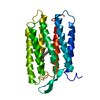
| ||||||||
|---|---|---|---|---|---|---|---|---|---|
| 1 | 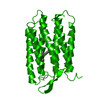
| ||||||||
| 単位格子 |
|
- 要素
要素
| #1: タンパク質 | 分子量: 26797.381 Da / 分子数: 1 / 由来タイプ: 天然 / 由来: (天然)  Halobacterium salinarum (好塩性) / 株: JW5 / 参照: UniProt: P02945 Halobacterium salinarum (好塩性) / 株: JW5 / 参照: UniProt: P02945 |
|---|---|
| #2: 化合物 | ChemComp-RET / |
| 構成要素の詳細 | THE SURFACE STRUCTURE IS NEW AND UNIQUE. ALPHA CARBONS' POSITIONS ARE SIMILAR TO 2BRD EXCEPT FOR ...THE SURFACE STRUCTURE IS NEW AND UNIQUE. ALPHA CARBONS' POSITIONS ARE SIMILAR TO 2BRD EXCEPT FOR THOSE NEAR THE MEMBRANE SURFACES. SOME OF THE SIDE CHAINS DIFFER CONSIDERAB |
| Has protein modification | Y |
-実験情報
-実験
| 実験 | 手法: 電子線結晶学 |
|---|---|
| EM実験 | 試料の集合状態: 2D ARRAY / 3次元再構成法: 電子線結晶学 |
- 試料調製
試料調製
| 構成要素 | 名称: Bacteriorhodopsin / タイプ: COMPLEX / 由来: NATURAL |
|---|---|
| 緩衝液 | pH: 5.5 / 詳細: 0.4 M citric acid Na2HPO4, 3% trehalose |
| 試料 | 包埋: YES / シャドウイング: NO / 染色: NO / 凍結: YES |
| 試料支持 | 詳細: specially ordered surface-polished to minimize wrinkles induced by cryo-fixation グリッドの材料: MOLYBDENUM |
| EM embedding | 詳細: 3% trehalose / Material: trehalose |
| 急速凍結 | 装置: REICHERT-JUNG PLUNGER / 凍結剤: ETHANE / 詳細: delay of 10 seconds before rapid freezing |
| 結晶 | マシュー密度: 4.23 Å3/Da / 溶媒含有率: 71 % |
| 結晶化 | *PLUS 手法: other / 詳細: Oesterhelt, D., (1974) Methods Enzymol., 31, 667. |
-データ収集
| EM imaging | 電子線源:
| |||||||||||||||
|---|---|---|---|---|---|---|---|---|---|---|---|---|---|---|---|---|
| 撮影 |
| |||||||||||||||
| 検出器 | 日付: 1992年4月1日 | |||||||||||||||
| 放射 | 散乱光タイプ: electron | |||||||||||||||
| 放射波長 | 相対比: 1 | |||||||||||||||
| 反射 | *PLUS 最高解像度: 2.8 Å / Num. obs: 9531 / % possible obs: 89 % / Num. measured all: 185305 / Rmerge(I) obs: 0.156 |
- 解析
解析
| ソフトウェア |
| ||||||||||||
|---|---|---|---|---|---|---|---|---|---|---|---|---|---|
| EMソフトウェア | 名称: CCP4 programs / カテゴリ: crystallography merging | ||||||||||||
| 3次元再構成 | 解像度: 2.8 Å / 解像度の算出法: DIFFRACTION PATTERN/LAYERLINES / 対称性のタイプ: 2D CRYSTAL | ||||||||||||
| 精密化 | 最高解像度: 2.8 Å 詳細: POSITIONAL REFINEMENT. ORIGINAL MODEL WAS PUBLISHED WITHOUT ANY REFINEMENT. A MODEL WAS PLACED TO FIT TO THE EXPERIMENTALLY OBTAINED MAP AND WAS CHECKED WITH RAMACHANDRAN PLOT BY USING ...詳細: POSITIONAL REFINEMENT. ORIGINAL MODEL WAS PUBLISHED WITHOUT ANY REFINEMENT. A MODEL WAS PLACED TO FIT TO THE EXPERIMENTALLY OBTAINED MAP AND WAS CHECKED WITH RAMACHANDRAN PLOT BY USING PROGRAM:PROCHECK. IT SHOWED A CONFIGURATION WITH RESIDUES 80.9% IN MOST FAVORABLE REGIONS, 15.5% IN ADDITIONAL ALLOWED REGIONS, 3.6% IN GENEROUSLY ALLOWED REGIONS AND 0% IN DISALLOWED REGIONS. SPECIAL POSITION/STRUCTURE DETERMINATION THE STRUCTURE WAS DETERMINED FROM TWO DIMENSIONAL CRYSTALS AND THEREFORE THE POSITION IN THE DIRECTION ALONG C AXIS IS ARBITRARY. IN ORDER TO HAVE POSITION OF THE CURRENT MODEL COMPARABLE TO 1BRD AND 2BRD IN PDB, THE AUTHORS FITTED THE MODEL TO 2BRD BY USING LSQ_EXP AND LSQ_MOL FUNCTIONS IN 4D_ONO PROGRAM AUTHORED BY ALWYN JONES. THE MATCHED POSITIONS ARE CA IN THE FOLLOWING ZONES: 10-25, 43-60, 82-98, 113-126, 135-145, 175-190, 204-222. | ||||||||||||
| 精密化ステップ | サイクル: LAST / 最高解像度: 3 Å
| ||||||||||||
| 精密化 | *PLUS Rfactor obs: 0.24 / Rfactor Rfree: 0.37 | ||||||||||||
| 溶媒の処理 | *PLUS | ||||||||||||
| 原子変位パラメータ | *PLUS |
 ムービー
ムービー コントローラー
コントローラー




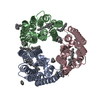


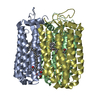
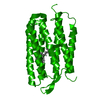
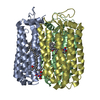
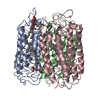
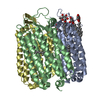

 PDBj
PDBj





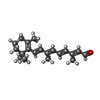

 FIELD EMISSION GUN
FIELD EMISSION GUN